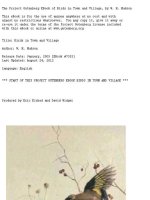The Project Gutenberg EBook of The Origin of Species, by Thomas H. Huxley docx
Bạn đang xem bản rút gọn của tài liệu. Xem và tải ngay bản đầy đủ của tài liệu tại đây (366.51 KB, 145 trang )
The Project Gutenberg EBook of The Origin
of Species, by Thomas H. Huxley
This eBook is for the use of anyone
anywhere at no cost and with
almost no restrictions whatsoever. You may
copy it, give it away or
re-use it under the terms of the Project
Gutenberg License included
with this eBook or online at
www.gutenberg.org
Title: The Origin of Species
From 'The Westminster Review', April 1860
Author: Thomas H. Huxley
Release Date: January 6, 2009 [EBook
#2929]
Language: English
*** START OF THIS PROJECT GUTENBERG EBOOK
THE ORIGIN OF SPECIES ***
Produced by Amy E. Zelmer, and David
Widger
THE ORIGIN OF
SPECIES
From 'The
Westminster
Review', April
1860.
[1]
By Thomas H. Huxley
MR. DARWIN'S long-standing and
well-earned scientific eminence probably
renders him indifferent to that social
notoriety which passes by the name of
success; but if the calm spirit of the
philosopher have not yet wholly
superseded the ambition and the vanity of
the carnal man within him, he must be
well satisfied with the results of his
venture in publishing the 'Origin of
Species'. Overflowing the narrow bounds
of purely scientific circles, the "species
question" divides with Italy and the
Volunteers the attention of general society.
Everybody has read Mr. Darwin's book,
or, at least, has given an opinion upon its
merits or demerits; pietists, whether lay or
ecclesiastic, decry it with the mild railing
which sounds so charitable; bigots
denounce it with ignorant invective; old
ladies of both sexes consider it a
decidedly dangerous book, and even
savants, who have no better mud to throw,
quote antiquated writers to show that its
author is no better than an ape himself;
while every philosophical thinker hails it
as a veritable Whitworth gun in the
armoury of liberalism; and all competent
naturalists and physiologists, whatever
their opinions as to the ultimate fate of the
doctrines put forth, acknowledge that the
work in which they are embodied is a
solid contribution to knowledge and
inaugurates a new epoch in natural history.
Nor has the discussion of the subject
been restrained within the limits of
conversation. When the public is eager
and interested, reviewers must minister to
its wants; and the genuine 'litterateur' is
too much in the habit of acquiring his
knowledge from the book he judges—as
the Abyssinian is said to provide himself
with steaks from the ox which carries him
—to be withheld from criticism of a
profound scientific work by the mere want
of the requisite preliminary scientific
acquirement; while, on the other hand, the
men of science who wish well to the new
views, no less than those who dispute
their validity, have naturally sought
opportunities of expressing their opinions.
Hence it is not surprising that almost all
the critical journals have noticed Mr.
Darwin's work at greater or less length;
and so many disquisitions, of every degree
of excellence, from the poor product of
ignorance, too often stimulated by
prejudice, to the fair and thoughtful essay
of the candid student of Nature, have
appeared, that it seems an almost hopeless
task to attempt to say anything new upon
the question.
But it may be doubted if the knowledge
and acumen of prejudged scientific
opponents, or the subtlety of orthodox
special pleaders, have yet exerted their
full force in mystifying the real issues of
the great controversy which has been set
afoot, and whose end is hardly likely to be
seen by this generation; so that, at this
eleventh hour, and even failing anything
new, it may be useful to state afresh that
which is true, and to put the fundamental
positions advocated by Mr. Darwin in
such a form that they may be grasped by
those whose special studies lie in other
directions. And the adoption of this course
may be the more advisable, because,
notwithstanding its great deserts, and
indeed partly on account of them, the
'Origin of Species' is by no means an easy
book to read—if by reading is implied the
full comprehension of an author's meaning.
We do not speak jestingly in saying that
it is Mr. Darwin's misfortune to know
more about the question he has taken up
than any man living. Personally and
practically exercised in zoology, in minute
anatomy, in geology; a student of
geographical distribution, not on maps and
in museums only, but by long voyages and
laborious collection; having largely
advanced each of these branches of
science, and having spent many years in
gathering and sifting materials for his
present work, the store of accurately
registered facts upon which the author of
the 'Origin of Species' is able to draw at
will is prodigious.
But this very superabundance of matter
must have been embarrassing to a writer
who, for the present, can only put forward
an abstract of his views; and thence it
arises, perhaps, that notwithstanding the
clearness of the style, those who attempt
fairly to digest the book find much of it a
sort of intellectual pemmican—a mass of
facts crushed and pounded into shape,
rather than held together by the ordinary
medium of an obvious logical bond; due
attention will, without doubt, discover this
bond, but it is often hard to find.
Again, from sheer want of room, much
has to be taken for granted which might
readily enough be proved; and hence,
while the adept, who can supply the
missing links in the evidence from his own
knowledge, discovers fresh proof of the
singular thoroughness with which all
difficulties have been considered and all
unjustifiable suppositions avoided, at
every reperusal of Mr. Darwin's pregnant
paragraphs, the novice in biology is apt to
complain of the frequency of what he
fancies is gratuitous assumption.
Thus while it may be doubted if, for
some years, any one is likely to be
competent to pronounce judgment on all
the issues raised by Mr. Darwin, there is
assuredly abundant room for him, who,
assuming the humbler, though perhaps as
useful, office of an interpreter between the
'Origin of Species' and the public,
contents himself with endeavouring to
point out the nature of the problems which
it discusses; to distinguish between the
ascertained facts and the theoretical views
which it contains; and finally, to show the
extent to which the explanation it offers
satisfies the requirements of scientific
logic. At any rate, it is this office which
we purpose to undertake in the following
pages.
It may be safely assumed that our
readers have a general conception of the
nature of the objects to which the word
"species" is applied; but it has, perhaps,
occurred to a few, even to those who are
naturalists 'ex professo', to reflect, that, as
commonly employed, the term has a
double sense and denotes two very
different orders of relations. When we
call a group of animals, or of plants, a
species, we may imply thereby, either that
all these animals or plants have some
common peculiarity of form or structure;
or, we may mean that they possess some
common functional character. That part of
biological science which deals with form
and structure is called Morphology—that
which concerns itself with function,
Physiology—so that we may conveniently
speak of these two senses, or aspects, of
"species"—the one as morphological, the
other as physiological. Regarded from the
former point of view, a species is nothing
more than a kind of animal or plant, which
is distinctly definable from all others, by
certain constant, and not merely sexual,
morphological peculiarities. Thus horses
form a species, because the group of
animals to which that name is applied is
distinguished from all others in the world
by the following constantly associated
characters. They have—1, A vertebral
column; 2, Mammae; 3, A placental
embryo; 4, Four legs; 5, A single well-
developed toe in each foot provided with
a hoof; 6, A bushy tail; and 7, Callosities
on the inner sides of both the fore and the
hind legs. The asses, again, form a distinct
species, because, with the same
characters, as far as the fifth in the above
list, all asses have tufted tails, and have
callosities only on the inner side of the
fore-legs. If animals were discovered
having the general characters of the horse,
but sometimes with callosities only on the
fore-legs, and more or less tufted tails; or
animals having the general characters of
the ass, but with more or less bushy tails,
and sometimes with callosities on both
pairs of legs, besides being intermediate
in other respects—the two species would
have to be merged into one. They could no
longer be regarded as morphologically
distinct species, for they would not be
distinctly definable one from the other.
However bare and simple this
definition of species may appear to be, we
confidently appeal to all practical
naturalists, whether zoologists, botanists,
or palaeontologists, to say if, in the vast
majority of cases, they know, or mean to
affirm anything more of the group of
animals or plants they so denominate than
what has just been stated. Even the most
decided advocates of the received
doctrines respecting species admit this.
"I apprehend," says Professor Owen 2,
"that few naturalists nowadays, in
describing and proposing a name for what
they call 'a new species,' use that term to
signify what was meant by it twenty or
thirty years ago; that is, an originally
distinct creation, maintaining its primitive
distinction by obstructive generative
peculiarities. The proposer of the new
species now intends to state no more than
he actually knows; as, for example, that
the differences on which he founds the
specific character are constant in
individuals of both sexes, so far as
observation has reached; and that they are
not due to domestication or to artificially
superinduced external circumstances, or to
any outward influence within his
cognizance; that the species is wild, or is
such as it appears by Nature."
If we consider, in fact, that by far the
largest proportion of recorded existing
species are known only by the study of
their skins, or bones, or other lifeless
exuvia; that we are acquainted with none,
or next to none, of their physiological
peculiarities, beyond those which can be
deduced from their structure, or are open
to cursory observation; and that we cannot
hope to learn more of any of those extinct
forms of life which now constitute no
inconsiderable proportion of the known
Flora and Fauna of the world: it is
obvious that the definitions of these
species can be only of a purely structural,
or morphological, character. It is probable
that naturalists would have avoided much
confusion of ideas if they had more
frequently borne the necessary limitations
of our knowledge in mind. But while it
may safely be admitted that we are
acquainted with only the morphological
characters of the vast majority of species
—the functional or physiological,
peculiarities of a few have been carefully
investigated, and the result of that study
forms a large and most interesting portion
of the physiology of reproduction.
The student of Nature wonders the more
and is astonished the less, the more
conversant he becomes with her
operations; but of all the perennial
miracles she offers to his inspection,
perhaps the most worthy of admiration is
the development of a plant or of an animal
from its embryo. Examine the recently laid
egg of some common animal, such as a
salamander or newt. It is a minute
spheroid in which the best microscope
will reveal nothing but a structureless sac,
enclosing a glairy fluid, holding granules
in suspension. But strange possibilities lie
dormant in that semi-fluid globule. Let a
moderate supply of warmth reach its
watery cradle, and the plastic matter
undergoes changes so rapid, yet so steady
and purposelike in their succession, that
one can only compare them to those
operated by a skilled modeller upon a
formless lump of clay. As with an
invisible trowel, the mass is divided and
subdivided into smaller and smaller
portions, until it is reduced to an
aggregation of granules not too large to
build withal the finest fabrics of the
nascent organism. And, then, it is as if a
delicate finger traced out the line to be
occupied by the spinal column, and
moulded the contour of the body; pinching
up the head at one end, the tail at the other,
and fashioning flank and limb into due
salamandrine proportions, in so artistic a
way, that, after watching the process hour
by hour, one is almost involuntarily
possessed by the notion, that some more
subtle aid to vision than an achromatic,
would show the hidden artist, with his
plan before him, striving with skilful
manipulation to perfect his work.
As life advances, and the young
amphibian ranges the waters, the terror of
his insect contemporaries, not only are the
nutritious particles supplied by its prey,
by the addition of which to its frame,
growth takes place, laid down, each in its
proper spot, and in such due proportion to
the rest, as to reproduce the form, the
colour, and the size, characteristic of the
parental stock; but even the wonderful
powers of reproducing lost parts
possessed by these animals are controlled
by the same governing tendency. Cut off
the legs, the tail, the jaws, separately or
all together, and, as Spallanzani showed
long ago, these parts not only grow again,
but the redintegrated limb is formed on the
same type as those which were lost. The
new jaw, or leg, is a newt's, and never by
any accident more like that of a frog. What
is true of the newt is true of every animal
and of every plant; the acorn tends to build
itself up again into a woodland giant such
as that from whose twig it fell; the spore
of the humblest lichen reproduces the
green or brown incrustation which gave it
birth; and at the other end of the scale of
life, the child that resembled neither the
paternal nor the maternal side of the house
would be regarded as a kind of monster.
So that the one end to which, in all
living beings, the formative impulse is
tending—the one scheme which the
Archaeus of the old speculators strives to
carry out, seems to be to mould the
offspring into the likeness of the parent. It
is the first great law of reproduction, that
the offspring tends to resemble its parent
or parents, more closely than anything
else.
Science will some day show us how
this law is a necessary consequence of the
more general laws which govern matter;
but, for the present, more can hardly be
said than that it appears to be in harmony
with them. We know that the phenomena
of vitality are not something apart from
other physical phenomena, but one with
them; and matter and force are the two
names of the one artist who fashions the
living as well as the lifeless. Hence living
bodies should obey the same great laws as
other matter—nor, throughout Nature, is
there a law of wider application than this,
that a body impelled by two forces takes
the direction of their resultant. But living
bodies may be regarded as nothing but
extremely complex bundles of forces held
in a mass of matter, as the complex forces
of a magnet are held in the steel by its
coercive force; and, since the differences
of sex are comparatively slight, or, in
other words, the sum of the forces in each
has a very similar tendency, their
resultant, the offspring, may reasonably be
expected to deviate but little from a
course parallel to either, or to both.
Represent the reason of the law to
ourselves by what physical metaphor or
analogy we will, however, the great
matter is to apprehend its existence and
the importance of the consequences
deducible from it. For things which are
like to the same are like to one another;
and if; in a great series of generations,
every offspring is like its parent, it
follows that all the offspring and all the
parents must be like one another; and that,
given an original parental stock, with the









